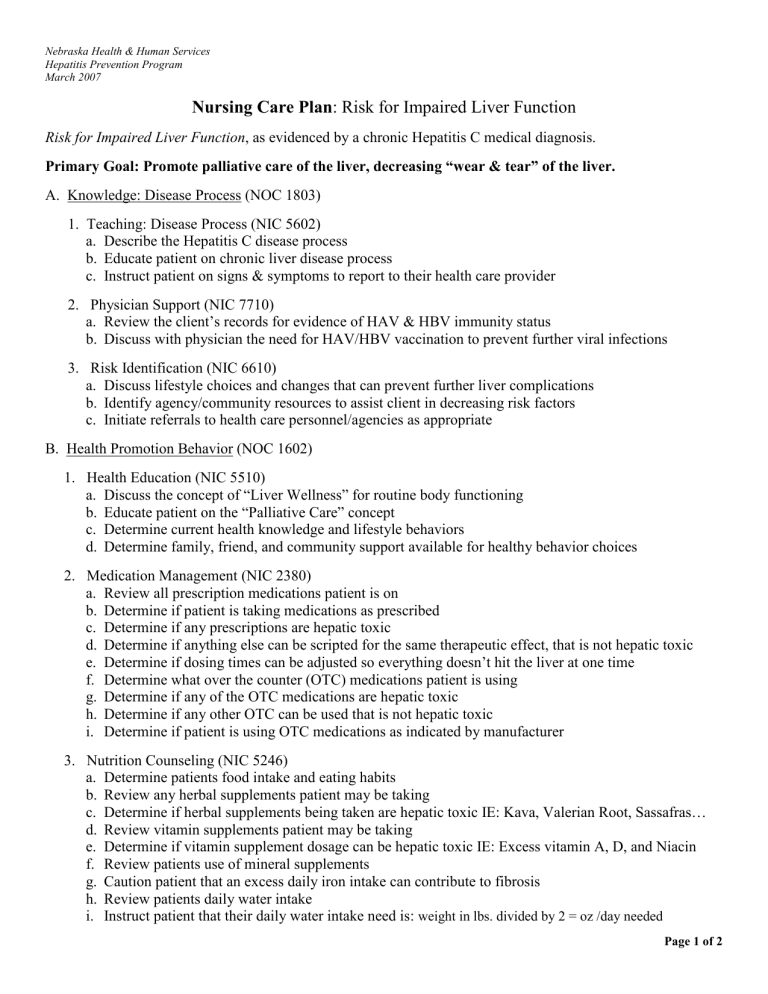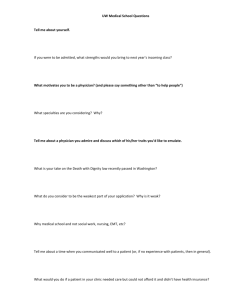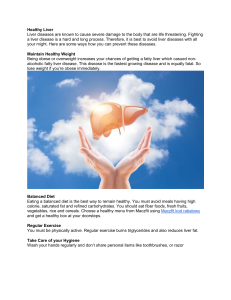
Nebraska Health & Human Services Hepatitis Prevention Program March 2007 Nursing Care Plan: Risk for Impaired Liver Function Risk for Impaired Liver Function, as evidenced by a chronic Hepatitis C medical diagnosis. Primary Goal: Promote palliative care of the liver, decreasing “wear & tear” of the liver. A. Knowledge: Disease Process (NOC 1803) 1. Teaching: Disease Process (NIC 5602) a. Describe the Hepatitis C disease process b. Educate patient on chronic liver disease process c. Instruct patient on signs & symptoms to report to their health care provider 2. Physician Support (NIC 7710) a. Review the client’s records for evidence of HAV & HBV immunity status b. Discuss with physician the need for HAV/HBV vaccination to prevent further viral infections 3. Risk Identification (NIC 6610) a. Discuss lifestyle choices and changes that can prevent further liver complications b. Identify agency/community resources to assist client in decreasing risk factors c. Initiate referrals to health care personnel/agencies as appropriate B. Health Promotion Behavior (NOC 1602) 1. Health Education (NIC 5510) a. Discuss the concept of “Liver Wellness” for routine body functioning b. Educate patient on the “Palliative Care” concept c. Determine current health knowledge and lifestyle behaviors d. Determine family, friend, and community support available for healthy behavior choices 2. Medication Management (NIC 2380) a. Review all prescription medications patient is on b. Determine if patient is taking medications as prescribed c. Determine if any prescriptions are hepatic toxic d. Determine if anything else can be scripted for the same therapeutic effect, that is not hepatic toxic e. Determine if dosing times can be adjusted so everything doesn’t hit the liver at one time f. Determine what over the counter (OTC) medications patient is using g. Determine if any of the OTC medications are hepatic toxic h. Determine if any other OTC can be used that is not hepatic toxic i. Determine if patient is using OTC medications as indicated by manufacturer 3. Nutrition Counseling (NIC 5246) a. Determine patients food intake and eating habits b. Review any herbal supplements patient may be taking c. Determine if herbal supplements being taken are hepatic toxic IE: Kava, Valerian Root, Sassafras… d. Review vitamin supplements patient may be taking e. Determine if vitamin supplement dosage can be hepatic toxic IE: Excess vitamin A, D, and Niacin f. Review patients use of mineral supplements g. Caution patient that an excess daily iron intake can contribute to fibrosis h. Review patients daily water intake i. Instruct patient that their daily water intake need is: weight in lbs. divided by 2 = oz /day needed Page 1 of 2 Nebraska Health & Human Services Hepatitis Prevention Program March 2007 4. Sleep Enhancement (NIC 1850) a. Determine patients sleep pattern b. Instruct patient they need 7-9 hours sleep/night c. Instruct patient to avoid bedtime food/beverages that interfere with sleep IE: Caffeine and Sugar d. Determine the effects of patient medications on sleep e. Adjust medication schedule to support patient sleep cycle C. Risk Control (NOC 1902) 1. Substance Use Prevention (NIC 4500) a. Determine patients use of alcohol/illegal drugs b. Ascertain from patient why they use alcohol or illegal drugs c. Instruct patient that any alcohol use is a cofactor in the rate of progression of liver disease d. Instruct patient that any illegal drug use can be a cofactor in the rate of progression of liver disease e. Assist patient to identify alternate coping/pleasure/social mechanisms 2. Teaching: Safe Sex (NIC 5622) a. Ascertain from patient if their sexual habits include high risk activities b. Educate patient regarding the hepatic toxic effect of HIV c. Instruct patient on the use of effective barrier protection d. Discuss with patient ways to convince sexual partners to use appropriate barrier protection Secondary Goal: Monitor patient for signs & symptoms of liver dysfunction. A. Personal Health Status (NOC 2006) 1. Laboratory Data Interpretation (NIC 7690) a. Monitor sequential test results for trends or gross changes 1). Liver Function Tests (ALT/AST/GGT/Bili): Increase with impaired liver function 2). Platelet Count: Increase with impaired liver function 3). PT/INR: Increase with impaired liver function 4). Albumin: Decrease with impaired liver function b. Compare laboratory data with other diagnostic tests c. Ensure the correct type and integrity of blood specimens d. Analyze whether laboratory results are consistent with patient behavior and clinical status 2. Physician Support (NIC 7710) a. Report sudden changes in laboratory data to physician immediately b. Report critical values (as determined by institution) to physician immediately c. Report onset of any Jaundice to physician immediately d. Report changes in patient status as appropriate 1). Onset or increase in bleeding gums 2). Increased bleeding time with everyday cuts/scrapes 3). Increased fatigue Page 2 of 2




